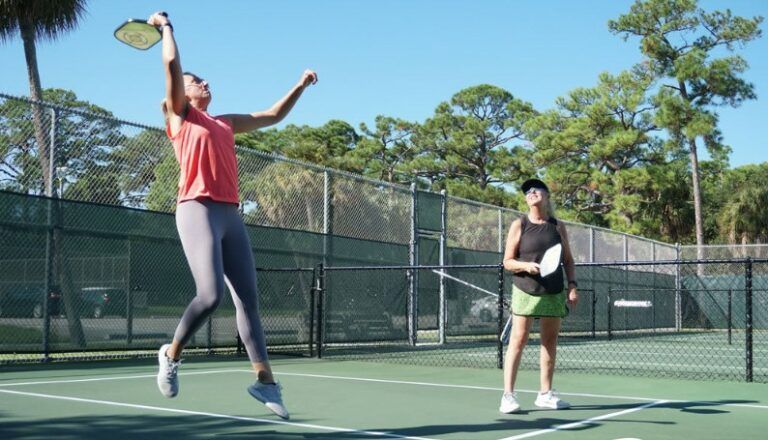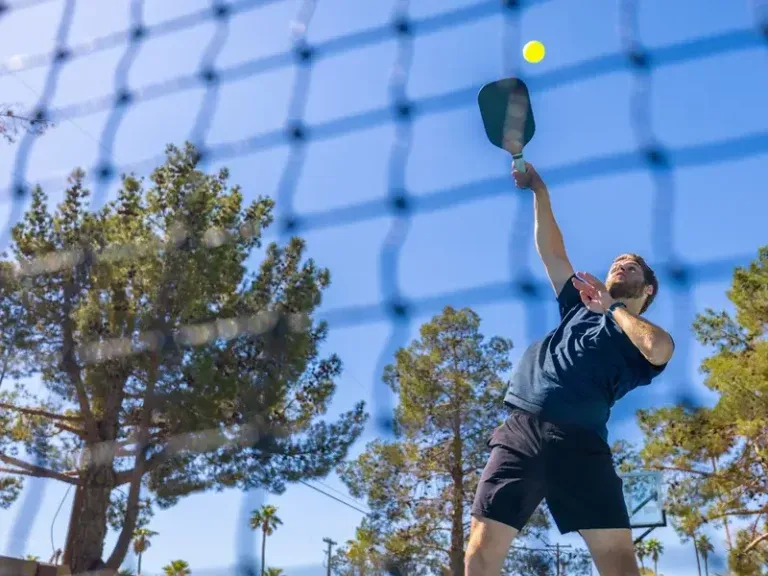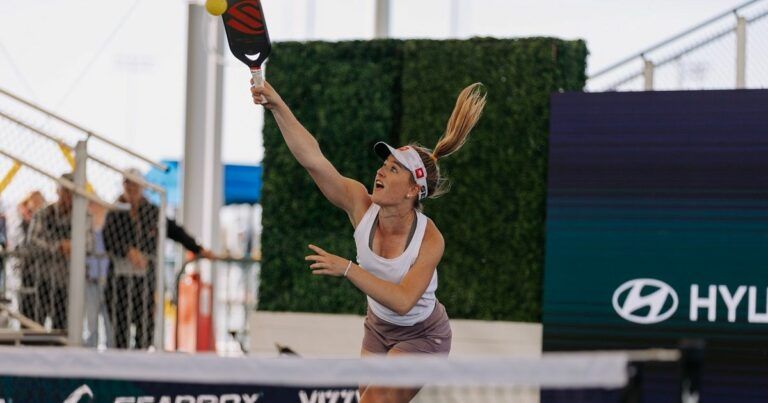Understanding the power of the pickleball overhead smash
The overhead smash is an essential component of any successful pickleball strategy. By striking the ball downward from above, players can deliver a forceful blow that leaves their opponents scrambling. This stroke is often used in response to high lobs, making it a perfect counter-attack move. Imagine swinging a thunderous hammer; the sound and force can be intimidating this is the effect of a well-executed smash.
The power derived from this shot comes from several factors, including technique, timing, and body mechanics. Each element contributes to an athlete’s ability to generate speed and force. Not only does the overhead smash serve as a point-scoring opportunity, but it can also psychologically impact opponents, instilling fear and uncertainty, which can be advantageous for the player delivering the smash.
What is the pickleball overhead smash?
In simplest terms, the overhead smash can be defined as a powerful shot that is executed when the ball is at or above the player’s head level. The objective is to hit the ball downwards onto your opponent's side of the court, ideally in a manner that makes it difficult for them to return it. This skillful maneuver requires precise mechanics and an understanding of one’s position relative to the ball.

There are two fundamental aspects that define the overhead smash: technique and mindset. Mastering the physical dimensions like positioning, grip, and follow-through forms the basis of an effective smash. Beyond the technique, a player’s mental acuity plays an equally pivotal role in correctly reading the game situation, choosing the right moment to execute the smash, and maintaining the confidence to follow through with power.
When to unleash the smash
Timing is critical when it comes to the overhead smash. The ideal moment to strike is just before the ball begins its descent. Performing the smash too early can result in a loss of power, while hitting it late often leads to a miss or a weak return. A good rule of thumb is to anticipate the trajectory of the ball while positioning oneself properly it’s akin to a cat ready to pounce; the preemptive positioning makes all the difference.
In addition to timing, players should consider an opponent’s positioning during a match. Knowing when to unleash this formidable shot comes down to reading their movements. Are they standing too close to the net, vulnerable to a powerful downward strike? Or are they ready for the smash, prepared to counter? Timing, combined with a well-informed strategy, can turn a straightforward shot into a point-winning play.
Laying the foundation: footwork for the perfect smash
Footwork serves as the bedrock of any successful overhead smash. To put it simply, without the right footwork, a strong smash can become weak and ineffective. Mastery of the overhead smash necessitates a keen awareness of body movement and positioning. It's not enough to just swing hard; players must work in harmony with their feet.

The pivot and shuffle: your first steps to success
To set up for a powerful smash, players need to utilize the pivot and shuffle technique effectively. The sequence begins with quick lateral movements to position oneself beneath the ball, akin to a dancer expertly gliding across the stage. The pivot allows players to transition seamlessly, while a well-timed shuffle helps them maintain balance and control.
The relationship between footwork and shot execution is critical; it's the link that facilitates fluidity in play. A player who can pivot quickly and shuffle effectively will find they can connect with the ball in a much more advantageous position, leading to higher chances of scoring.
Avoiding the dreaded kitchen fault
Understanding the rules surrounding the “kitchen” area is equally important for players looking to master the overhead smash. The non-volley zone, commonly known as the kitchen, is a critical component of pickleball. Players must ensure they remain outside this area when executing the smash. Stepping into the kitchen to make a strike can result in a fault, leading to lost points and ultimately impacting game momentum.
Players should consistently practice their footwork to ensure they maintain compliance with the rules while executing smashes from powerful positions. This means habitually checking oneself before swinging to eliminate any risk of incurring a fault.
Body positioning: setting yourself up for the kill
Beyond footwork, body positioning plays an equally significant role in executing a successful overhead smash. It’s the cornerstone upon which the techniques build, dictating the power and accuracy of each shot

The sideways stance: unlocking power and reach
Adopting a sideways stance is crucial when preparing for the overhead smash. This positioning allows players to maximize their reach while also engaging their core muscles effectively. When players stand parallel to the net, they can rotate their hips and shoulders more efficiently, adding significant power to the shot.
The sideways stance is not only about technique but also about strategy; it indicates readiness and confidence, qualities that can be communicated to opponents. When a player adopts this stance, it signals an intention to strike, assuming an aggressive posture that can mentally unsettle an opponent.
The role of the non-dominant arm
In the intricate dance of an overhead smash, the non-dominant arm is often overlooked, yet it plays a crucial role in maintaining balance and tracking the ball. While the dominant arm executes the smash, the non-dominant arm should extend outward, guiding focus towards the ball. This extension augments stability and allows for better follow-through after contact.
Players should practice synchronizing both arms, ensuring that their movements complement each other. It is this coordination that helps create a sense of rhythm and confidence in each strike, setting the foundation for a consistent and powerful overhead smash.
Mastering the swing: from setup to follow-through
A successful overhead smash is marked by a fluid swinging motion, wherein the player transitions seamlessly from preparation to execution. Mastering this aspect is imperative for players aiming for effectiveness on the court.
The throwing motion: unleashing maximum power
The swing used in the overhead smash strongly resembles a throwing motion. Players should bring their paddle back behind their heads, preparing for the strike as though throwing a ball. This technique unleashes a host of muscles, generating maximum power. It’s akin to winding up a spring, ready to unleash energy at the right moment.
Focusing on engaging the shoulder, core, and arm muscles simultaneously will enhance the smash's overall power. Active engagement of these muscle groups during practice can improve overall technique, translating directly into a stronger shot during matches.
Generating power: engaging your entire body
To further enhance power in the overhead smash, players must harness the kinetic chain. This concept involves the connection of muscle movements that occur in a coordinated sequence. Use the entire body from legs to core to arms to generate a surge of energy that is transferred into the swing.
- Legs: Generate initial momentum through powerful leg drive.
- Core: Transition energy through the torso, loading and unleashing strength.
- Arms: Finally, the arms channel this energy into the paddle as the contact is made.
By focusing on these muscle groups, players can cultivate a powerful swinging motion that carries through the entirety of the overhead smash.
Contact point and control: making solid contact every time
Critical to the overhead smash is the contact point the moment the paddle meets the ball. Ensuring that players make solid contact not only increases the likelihood of a successful smash but also enhances control, limiting the unpredictability that may arise during a match.
Finding the sweet spot: the optimal contact zone
The optimal contact point is at the highest point of the ball's trajectory, just before it begins to descend. Hitting the ball at this moment maximizes both speed and control. Imagine trying to capture a butterfly mid-flight; you want to approach it at the moment it's hovering right above you for the best chance of success.
Each player should identify their “sweet spot” through practice, noting where they achieve the best connection with the ball. This knowledge becomes a powerful tool during matches, allowing instinctual movement toward the ball for optimal striking.
Common contact errors and how to fix them
Even the most seasoned players can falter in their contact. Some common mistakes to watch for include:
- Too Early Contact: Engaging the ball too soon can lead to weak volleys.
- Too Late Contact: Missing opportunities or hitting before the ball descends can lead to infrequent scoring.
- Poor Paddle Angle: An incorrect paddle angle can result in unpredictable ball trajectories, making it easier for opponents to intercept.
By actively recognizing and addressing these errors, players can make adjustments that refine their technique to better harness the power of their overhead smash.
Shot placement and strategy: turning smashes into winners
Executing the perfect shot is not only about power and technique but also about placement. The ability to place the smash wisely transforms it from a mere shot into a point-winning opportunity.
Targeting your opponent's weaknesses
When aiming for shot placement, studying an opponent's weaknesses is paramount. Are they favoring one side of the court? Do they struggle with certain angles? Identifying these gaps provides valuable insights regarding where to direct the smash for maximum effect. Strategic placement often dictates the outcome of the point.
- Analyze opponent’s movement: Look for signs of hesitation or vulnerability.
- Utilize footwork: Move into a position that allows you to strike with optimal power.
By focusing on the weaknesses of opponents, players can turn an ordinary smash into a skillful tactical play.
Angles: the element of surprise
Incorporating angles into the overhead smash creates additional layers to a player's strategy. Hitting the ball at an angle can challenge the opponent's response time and positioning on the court. Just as a well-placed chess move can put an opponent into check, cleverly angled smashes can leave opponents scrambling.
Utilize the corners of the court effectively. The narrow openings often create unexpected opportunities for scoring. During practice, players should experiment with diverse angles to observe which positions yield the best outcomes.
Drills to elevate your smash game
As with all aspects of sports, practice makes perfect. Regular drills focused on the overhead smash can help players solidify their technique and improve their overall gameplay.
Wall drills: solo training for smash mastery
Engaging in wall drills allows players to practice timing, footwork, and swing mechanics independently. Standing a few feet from a wall, players can toss the ball against the wall, simulating high lobs. This exercise enhances their ability to track and respond to ball trajectories while refining their smash technique without the need for a partner.
Partner drills: simulating game-day pressure
Practicing with a partner adds a layer of realism that enhances the skills required in an actual match. By lobbing the ball to each other, players can simulate game conditions, incorporating strategies that involve shot placement and movement. Such dynamic practice is invaluable for developing consistency, adaptability, and confidence.
Advanced techniques: taking your smash to the next level
For players looking to pursue further mastery of their overhead smash, exploring advanced techniques can elevate their game significantly.
The "extra step": unleashing explosive power
Adding an “extra step” before engaging the ball can amplify power. By stepping into the shot with a leading foot, players can create a stronger momentum shift, propelling the smash further while also increasing control.
Creating lag: the secret to a faster, more powerful smash
Mastering the creation of lag during the swing provides another advanced layer to the smash. This involves delaying the release of energy until just before contact, resulting in increased acceleration and force.
Players should practice the timing of this lag until it becomes instinctual, identifying moments where a delayed action can turn a good shot into a great one.
Smashing against different opponents: anticipating and adapting
To further elevate one’s receiving technique, players must also learn how to adapt their shots in response to different opponents. Recognizing their style and responding appropriately can significantly influence the outcome of a match.
The defensive-minded opponent: strategies for success
When facing a defensive-minded player, it’s essential to remain aggressive with shot placement and usage of power. Recognizing when to challenge their defenses effectively can lead to opening pathways for scoring.
The aggressive opponent: counter-smashing tactics
Conversely, when confronting an aggressive opponent, defensive strategies should be employed. Aiming for accuracy over sheer power may yield better results, with a focus on maneuvering shots that capitalize on their eagerness to strike.
The mental game: confidence and decision-making
A player’s mindset significantly impacts their proficiency on the court, especially in executing smashes. Building a strong mental game is just as crucial as physical training.
Developing a "smash mentality": believing in your shot
Believing in your smash can increase its success rate. Players should cultivate a mindset focused on positivity and confidence, visualizing each smash as a successful play before it occurs.
Reading your opponent: anticipating the lob
Additionally, being attuned to the opponent's intentions can enhance decision-making. By studying their movements and predicting potential lobs, players can effectively position themselves to capitalize on opportunities, ensuring they are ready to unleash a powerful smash when it counts.
Troubleshooting common overhead smash problems
Despite strong practice and preparation, overhead smash issues can persist. Identifying and correcting these problems is fundamental to refining gameplay.
Hitting the ball into the net: diagnosing and fixing the issue
When players routinely hit the ball into the net, it can indicate several problems related to timing or contact. Practicing consistently with adjustments in movement and grip can help address these issues.
Lack of power: increasing your smash velocity
For players struggling to generate power, reinforcing footwork mechanics can facilitate more explosive energy. Diligent practice to improve grip technique and swinging mechanics can help elevate the velocity of the smash.
Conclusion
Mastering the overhead smash is a journey that combines physical prowess, strategic thinking, and a positive mindset. From proper footwork and body positioning to advanced techniques and psychological acuity, each element converges to elevate a player’s game on the court. As you hone these skills through practice, the overhead smash will transform into a weapon of choice, capable of shifting the tides of any match. As with any great athlete, the path is steep but rewarding, taking not only skill but determination and perseverance. With the right focus and commitment, you can dominate the court and become a force to be reckoned with in the world of pickleball.










